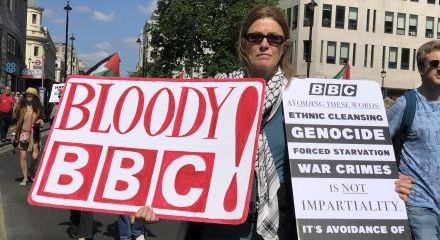22.05.2025

Silence of the Beeb
Israel is using food as a weapon of war. Despite recent token gestures, the Gazan population faces starvation. David Lammy huffs and puffs but allows the export of arms to continue. As for Donald Trump, says Ian Spencer, he is more interested in real-estate deals
It was not only the bright spring sunshine in London which gave an almost surreal quality to the 27th national Palestine solidarity demonstration. An estimated 600,000 of us took to the streets and yet you would not know it from the coverage on the BBC: not only was it not on TV, but you will search the BBC website in vain for any reference to the May 17 demonstration at all.
One would have thought that opposition to bombing and starving 2.2 million people was a newsworthy event. Indeed, if the polls are to be believed, a clear majority of people in Britain oppose Israel’s operations in Gaza. One does not have to be unduly cynical to suspect that the BBC is deliberately consigning one of the biggest demonstrations of recent years to the memory hole. You must turn to Al Jazeera, social media or the left press to get any idea of its scale.
The size of the demonstration was in no small part due to the 77th anniversary of the Nakba and the launch of Israel’s Gideon’s Chariots plan to escalate its offensive, including a full reoccupation of the shattered Palestinian enclave. Israel resumed its attack on Gaza in March, after breaking a two-month ceasefire - ostensibly to free the remaining hostages, but in fact to ‘finish the job’ of ethnic cleansing. Most recently, the Israel Defence Forces issued another evacuation order for the city of Khan Yunis, concentrating the population even further. Over 70% of Gaza is now in Israeli militarised zones or under displacement orders. There are no safe spaces in the Gaza Strip.
No aid
Since March 2, for 11 weeks Israel has cut off supplies of food, fuel, medicine and aid, exacerbating hunger and malnutrition.
In brief remarks made on May 4, Donald Trump acknowledged that Gazans were “starving” and suggested Washington would help get food into the strip. On May 18 Israel announced that it would allow “minimal” aid into the strip to prevent a “hunger crisis” - it allowed five lorries carrying humanitarian aid (mostly baby food) into the territory the next day. Tom Fletcher, the UN’s humanitarian aid chief, said that it was “a drop in the ocean of what is urgently needed”.1 He went on to warn that 14,000 babies could die in Gaza in the next 48 hours under Israel’s blockade. As of May 20, the 93 trucks waiting at the Karem Shalom crossing had not delivered their aid to UN distribution points.2 Fletcher is a British career diplomat, who used the term ‘genocide’ speaking to the UN security council on May 13, to describe what is happening in Gaza, in an excoriating critique of Israel and the impotence of the UN.3
Along with Trump, who avoided Israel on his recent visit to the Middle East, other Israeli allies, such as France, Canada and even the UK, felt able to speak out against the “egregious violence”. Canada has threatened sanctions, and the EU is reviewing trade agreements. Even David Lammy, possibly with one eye on future trials in the international courts, has suspended talks on a trade deal with Israel. He has summoned the country’s ambassador and described the military escalation in Gaza as “morally unjustifiable”. However, there is no sign that the UK will suspend any more weapons export licences, prevent the use of RAF Akrotiri in Cyprus as a base for reconnaissance flights or as a staging post for the delivery of US military aid to Israel.
We have seen 19 months of slaughter and, while estimates vary - depending on whether you count the thousands under the rubble and the excess deaths resulting from the denial of medical care for the full range of conditions - the fact that around 53,000 have been killed, is shocking enough. According to the World Health Organisation, recently stripped of funding by the Trump administration, the entire population of Gaza is facing food shortages. The latest analysis from the Integrated Food Security Phase Classification (IPC), of which the WHO is a member, reveals that most of the people of Gaza are in a catastrophic situation of hunger, acute malnutrition, starvation, illness and death.4
Famine has yet to be declared, but people are starving now. Three quarters of Gaza’s population are at “emergency” or “catastrophic” food deprivation - the two worst levels on the IPC’s scale. If the situation persists, nearly 71,000 children under five are expected to be acutely malnourished over the next 11 months, according to the IPC.5
People in Gaza are trapped in a dangerous cycle, where malnutrition and disease fuel each other, turning everyday illness into a potential death sentence. Malnutrition weakens the immune system and makes the healing of even simple wounds much slower.
Meanwhile, over 121,000 people have been wounded in Gaza, and these are not simple wounds. 22,500 have sustained life-changing injuries, including amputations, spinal cord trauma, traumatic brain injuries and major burns. Gaza has the highest number of child amputees per capita worldwide, with its healthcare system increasingly unable to help them owing to the deliberate destruction of hospitals by the IDF. More than 10 children are losing one or two limbs every day in Gaza.6 According to Unicef, the UN children’s security fund, there are at least 1,000 child amputees.7
Many of the malnutrition-related deaths are due to common diseases like pneumonia and diarrhoea, which children are particularly susceptible to, while pregnant and breast-feeding mothers are also at high risk of malnutrition. Linked to this is the fact that the IDF has systematically targeted the water supply. Where clean water is scarce, breastfeeding is an infant’s best hope of survival, but that presupposes that the mother is well nourished enough to produce milk. Malnutrition also has effects that will last for years, even if food were plentiful from today. This can even extend to future generations, as it is known to exert a catastrophic effect on epigenetic factors in the population, leading to birth defects, stunted growth and cognitive impairment.
UN criteria
There is now an increasing likelihood of widespread famine. According to UN criteria, famine is when at least 20% of a given population face extreme shortages, more than 30% of children suffer from acute malnutrition and at least two out of every 10,000 people or four out of every 10,000 children die each day from hunger-related causes.
After fat stores are depleted the body is dependent on muscle and bone for energy. Severe protein deficiency causes fluid retention and a swollen abdomen in children. More than 9,000 children have been admitted to hospital for treatment of acute malnutrition since the start of the year, according to the UN.8
Hunger weapon
As hunger is weaponised by Israel, the people of Gaza face not just starvation, but continuing bombing too. Tom Potokar, a British plastic surgeon stationed in southern Gaza with the charity Ideals, has reported that the bombing is “shredding people to pieces”. He was at work in Gaza European Hospital when it was hit by Israeli bombs. Hundreds of people have been killed in recent days and Israeli tanks have rolled into the strip from the north and south. The 61-year-old consultant, who previously worked at the Welsh Centre for Burns and Plastic Surgery in Swansea, has had to move hospital three times as a direct consequence of Zionist bombing. Since Israel violated the ceasefire in March, at least 3,131 Palestinians have been killed and 8,600 have been injured.9
Trump’s apparent recent remarks about starvation in Gaza should give no grounds for optimism about his concern for peace, as seen by his signing of a $142 billion arms deal with Saudi Arabia. At best, it promises a transient respite in a relentless campaign aimed at removing the Palestinian population. It is a symbolic act - about as effective as the British government’s sanctioning of a handful of named settlers on the West Bank, while the ongoing settler violence undergoes a dramatic surge, assisted by the IDF.
The US president’s Middle East tour to the United Arab Emirates and Qatar has been a boost for the Trump family real-estate business. Aside from the lucrative Saudi arms sales for US weapons manufacturers, the ‘gift’ of a $400 million Jumbo jet from Qatar is a measure of Trump’s priorities. He gives every indication that his real-estate ambitions for Gaza have not ended. He told reporters on May 15, “I have concepts for Gaza that I think are very good. Make it a freedom zone,” he said. “Let the United States get involved, and make it just a freedom zone.”
The United States is very much involved, as is the UK, as co-belligerents, alongside Israel, and that is just the point. The marchers, commemorating the 77th anniversary of the Nakba, understand better than most what really needs to happen: the cessation of all military and economic aid to Israel, the closure of all Israeli military infrastructure in the UK and USA, equal rights for all in Palestine/Israel, the end of occupation and the right of return for Palestinians.
-
www.france24.com/en/middle-east/20250519-first-aid-trucks-entering-gaza-are-a-drop-in-the-ocean-says-un-aid-chief.↩︎
-
www.theguardian.com/us-news/2025/may/20/first-thing-un-says-14000-babies-could-die-in-gaza-in-next-48-hours-under-israeli-aid-blockade.↩︎
-
www.ipcinfo.org/ipcinfo-website/alerts-archive/issue-97/en.↩︎
-
www.who.int/news/item/12-05-2025-people-in-gaza-starving--sick-and-dying-as-aid-blockade-continues.↩︎
-
Ibid.↩︎
-
www.newyorker.com/news/dispatch/the-children-who-lost-limbs-in-gaza.↩︎
-
www.aljazeera.com/news/2025/5/16/what-is-famine-and-why-is-gaza-at-risk-of-reaching-it-soon.↩︎
-
www.telegraph.co.uk/world-news/2025/05/20/bombs-in-gaza-shredding-people-to-pieces.↩︎
